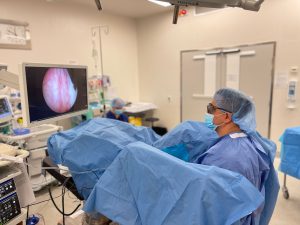Who is suitable for Transurethral Resection of Prostate (TURP)?
What are the advantages of TURP or Transurethral Resection of Prostate?
How is TURP performed?
What to expect after Transurethral Resection of Prostate (TURP)?
Procedure outcomes
Post-Operative Care Instructions
Transurethral Resection of Prostate (TURP) is a safe and definitive surgical treatment for enlarged prostate (BPH). There is more than 50 years of history behind this approach. As a result, the bothersome symptoms of enlarged prostate (BPH) can be eliminated or reduced significantly.
Doctors Shekib Shahbaz and Tony de Sousa of Melbourne Urology Centre are highly experienced in this procedure. They offer a personalized service and can discuss your options including suitability for this treatment option.
Dr Shekib Shahbaz performing a TURP

Who is suitable for Transurethral Resection of Prostate (TURP)?
- Those experiencing moderate to severe symptoms of enlarged prostate (BPH)
Weak stream of urine- Incomplete emptying of the bladder
- Stop and start when urinating
- Straining to begin urination
- An increased need to urinate
- Interrupted sleep because of the need to urinate
- Complications of enlarged prostate
- Those who have enlarged prostate symptoms and failed minimally-invasive treatment options
- Those whose prostate anatomy is not appropriate for other treatment options
- Those who have failed medical therapy, don’t want to take medication or have had side effects
- Those who want to improve their quality of life to what it was before BPH symptoms
What are the advantages of TURP or Transurethral Resection of Prostate?
Transurethral Resection of Prostate (TURP) is a definitive surgical treatment for enlarged prostate (BPH) for the relief of bothersome urinary symptoms:
- Consistent results with more than 50 years data available
- Durable improvement in urinary symptoms with low revision rates
- Quick recovery with minimal down-time after surgery
- Eliminates the need for lifelong use of medications
How is TURP performed?
- Transurethral Resection of Prostate (TURP) is performed under general (or spinal) anaesthesia
- It involves the use of a small telescope (cystoscopy) and energy source to remove the enlarged obstructing prostate tissue, creating an open prostatic urethra (channel)
- There are no skin incisions involved
- TURP takes up to an hour to complete
- Patients should expect to remain in hospital with a catheter for 1-2 nights.
What to expect after Transurethral Resection of Prostate (TURP)?
- The recovery is done at home and in most cases ‘light’ normal activities can be resumed as soon as 3-5 days post procedure. Complete recovery can take up to 4 weeks in which time strenuous activity should be avoided.
- The most common side effects Transurethral Resection of Prostate (TURP) include discomfort or burning with urination, blood in the urine, urgent need to urinate and/or difficulty controlling the urge. Most of these symptoms generally subside within the first two weeks following procedure.
Procedure outcomes
- Most patients will notice an immediate improvement in their urinary flow, pressure and bladder emptying
- Bladder symptoms of urinary frequency, urgency and nocturia (getting up at night to pass urine) tend to take longer (up to 3 months) to improve
Post-Operative Care Instructions
What to expect:
- Improved urinary flow, pressure, and bladder emptying.
- Blood in the urine is common for 2-4 weeks following your procedure, but in some cases it may take longer to resolve. This may be intermittent.
- Urination frequency and urgency (urinating often and in a hurry) as well as nocturia (waking at night to urinate) take longer to improve, and in most patients will settle within 3 months. In some circumstances symptoms may persist. Some patients may benefit from bladder retraining with a pelvic floor physiotherapist.
- Burning and stinging with urination may last days or up to weeks following the procedure. This does not usually indicate infection, but is part of the healing process. You may use Ural (available over the counter at pharmacies) to alleviate your symptoms.
- Retrograde (dry) ejaculation is common (90%), expected, and if it occurs it is permanent. This is not dangerous.
Return to activity:
- Driving – no driving for 2 weeks following surgery
- Work – you will require some time off work. The duration depends on your occupation
- Lifting – avoid heavy lifting or straining to open bowels for at least 4 weeks after surgery, to minimize the risk of secondary bleeding
- Activities – walking is fine and encouraged after surgery. Strenuous activity including running, gym, golf, cycling and swimming should be avoided for 4 weeks.
- Sex – avoid for 4 weeks.
Pain Management:
You may take ibuprofen or paracetamol if you are experiencing pain or discomfort. Ural sachets (available over the counter at pharmacies) can help with burning or stinging with urination.
Head to your nearest hospital emergency room if you have:
- You unable to urinate (this may be due to secondary bleeding and clots; this can occur within the first month or so after surgery)
- Fevers, chills or shakes (may indicate infection).
Follow-Up Information:
Our rooms will contact you to arrange a follow-up appointment with your urologist, typically 6-8 weeks following surgery
Your follow-up appointment is on: ____________________ at __________________.
Contact Information:
If you have any questions or concerns that are not addressed here or in the procedure information available on our website melbourneurologycentre.com.au contact our rooms on 1300 702 811 or [email protected]
Post-Operative information for this procedure can be found here: Transurethral Resection of Prostate (TURP) Post-Operative Care Instructions
Written by Dr. Shekib Shahbaz and Dr. Tony de Sousa
Teo, J. S., Lee, Y. M., Ho, H. S. S., (2017), An update on transurethral surgery for benign prostatic obstruction, Asian Journal of urology, 4(3),[https://www.ncbi.nlm.nih.gov/pmc/articles/PMC5717978/], accessed 26/02/21.
European Association of Urology, (2021), Transurethral resection of the prostate (TURP),[https://patients.uroweb.org/treatments/transurethral-resection-prostate-turp/], accessed 26/02/21.
